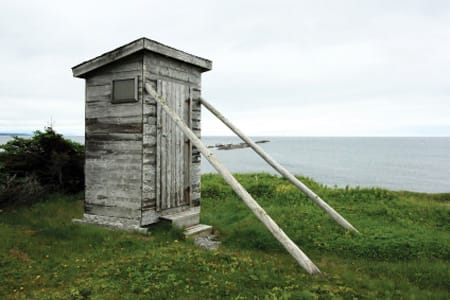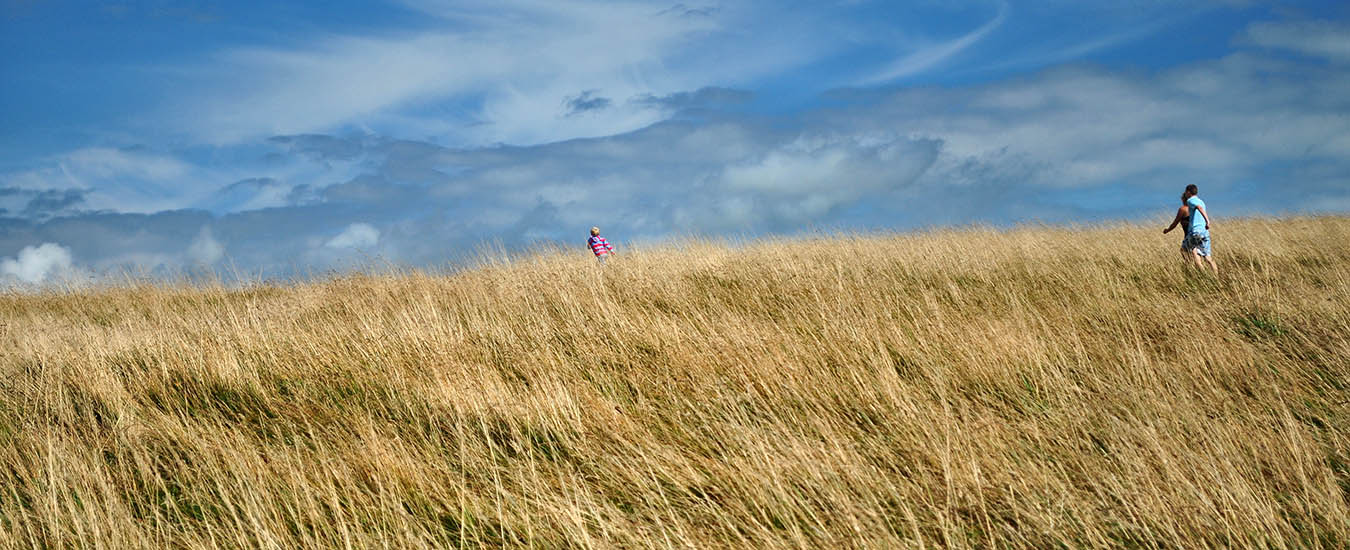Peering at the iconic structure that strikes a memorable pose.
I am old enough to have kids old enough to wax nostalgic on what life was like when they were young. My children think things have changed a lot, and in time they will surely tell their children stories about how crude and basic things were "way back in the early 80s," before cell phones, DVD players, digital cameras and YouTube.
Big deal.
They don't have stories like we do. We who grew up in the country when things were truly basic. Heat from a wood stove. Water brought in buckets from a well. Bathing by way of a wash basin and face cloth. Milk and butter from the family cow. Slaughtering the family pig.
The list goes on, but the thing that causes the grandchildren's jaws to drop, without fail, is the outhouse.
It's hard to say why. Perhaps because of the personal nature of the activity involved, and taboos surrounding our naughty bits. But surely, one big factor is that, however primitive life was back then, indoor things (cooking, eating, sleeping, bathing) have always been indoor things, and outdoor things (getting milk, eggs and ham) have always been outdoor things.

Except this one: it has crossed the great divide between the comfort of indoors and the drizzle of outdoors.
Picture a little building, four or five feet square. (In French, we called it la p'tite maison.) The floor, walls and roof were framed in two-by-fours, just like any other building, boarded over on the outside, then shingled or clapboarded. Many had a peaked roof, although some had a single-slope shed roof; the walls were six to seven feet high.
They were equipped with a door, of course, for privacy, and to keep out the elements. Often the door was similar to the house's winter storm door - made of boards running vertically, all nailed to three more boards, either running parallel or forming the shape of a "Z."
The doors were fitted with devices to keep them shut while someone was in there (usually a gate hook) and also to keep them shut when no one was in there (often another gate hook). Gate hooks were popular. Some families had as many gate hooks as children.
Another common outside latch consisted of a short strip of wood, attached to the door frame by a nail through the middle, which could be pivoted a quarter-turn to overlap the edge of the door. This homemade latch was popular because (1) gate hooks cost money, (2) getting one meant going to the store and (3) making a latch yourself was in line with the value system of country folk. That value system is best summed up this way: city people tended to make what they couldn't buy, country people tended to buy what they couldn't make.
Many outhouses were not finished - the wood was simply left to weather to the colour known in Newfoundland as Outport Grey. There was always whitewash, a cheap finish made by dissolving slaked lime in water, often used on fences. And in some cases outhouses were painted every bit as nicely as homes, with matching colour schemes.
A window was a vital feature, and placing it well above eye level was recommended to guard against those nasty people we referred to by their (mispronounced) English name: robberneckers. If you don't believe me that a bit of light was important, try leaving all the lights off the next time you get up in the night to use the bathroom.
If we can just move inside now, I'll show you around. I feel like a real estate agent.
Like other outbuildings on a rural property, many outhouses were unfinished on the inside. Others were painted with paint leftover from other projects; some were whitewashed and a few had the whole inside painted in one single colour - fancy schmancy. The odd one was wallpapered, which was a tough slog: every 16 inches you ran into a two-by-four wall stud.
Papering was worth the trouble, though, because covering the inside walls helped to cut down on cold draughts assaulting delicate regions.
Then we come to the workstation. If this were a dentist's office, it would be called the chair.
At the back of the outhouse was a bench, usually running the full width, its top and front boarded over. A hole was cut into the top. If the grasp of geometry and scribing skills of the builder were limited, he'd (or she'd) likely use two nails and a bit of string to scratch a perfect circle into the boards.
The more advanced, or adventurous, would cut out the oval shape of the modern toilet seat.
Generally, there was a slight bevel applied to the upward-facing edges of the hole - a newly cut hole, fresh off the coping saw, would have been a bloody nightmare of splinters, so more finishing was called for. No one seems to know if the bevel was applied with pocket knife, drawknife or spoke shave. Outhouse holecraft is a lost art.
There were other holes, I'm sure, made by craftsmen familiar with the use of sandpaper, whose smooth seatwork would have been greatly appreciated by those interfacing with it.
Often, there was more than one hole. I've seen three-holers, and read of a Montana hotel whose outhouse had 12. Honestly. The mind reels. And confusion arises because I never once saw more than one person use an outhouse at a time. The only sensible explanation is that the holes were of different sizes to allow various members of the family to choose a berth suited to the size of their hull. And so I wonder whether it was actually a backward step when we went to indoor flush toilets where everyone, regardless of mass or displacement, uses the same seat.
Now, moving on to the business end of the business end: under the bench was a pit. Not all that deep - I never dug one myself, but I'd be surprised if it was more than two feet, maybe three. I'm guessing, but it was a pit, not a well. It was not a composter; simply a receptacle that received incoming cargo, and it just - is there any delicate way to put this? - it just piled up.
When the top of the pile was too close for comfort, the lady of the house nagged the gentleman of the house until he sprinkled slaked lime on it. This had the effect of reducing the height, mass and smell of the pile, and repelling bugs.
Another product not to be forgotten was MistoVan, a liquid sold in a yellow and green can, if memory serves. And some people would spread wood ashes from their kitchen stove in the pit.
Apart from chemicals, ventilation was helpful. It was common to leave the eaves open to allow air to move through. Some outhouses had a pipe or wooden chimney running up the back from the pit to the roofline, to suck air from down below and vent it away up high.
Of course, the numerous cracks and crevices presented entranceways for all manner of creepy-crawlies. Mosquitoes and black flies, who make a living from bare skin, found the outhouse to be what war-game enthusiasts call a "target-rich environment." Other insects, such as bluebottle flies, sowbugs, spiders and moths, while a nuisance, at least didn't bite.
And the garter snakes, which, I note with mixed feelings, seem pretty scarce these days. On rare occasions, one of these creatures might decide to seek respite from the scalding summer sun by slithering into an outhouse, unaware that company might arrive at any minute.
Ask a man what he remembers about the outhouse days, and he's likely to say, "Well, they weren't so bad, I guess. You could do what you had to do in them, that's the main thing. But they were a little crude." To which a woman would say, "a little crude!"
The vantage point of the men's stories is often from the outside of the outhouse. They will tell you how pranksters were unable to resist tipping outhouses over. They were freestanding structures, after all, and small enough that a couple of boys could put their shoulders to one and topple it over. If there was someone in there, they might decide against it. Or be twice as delighted to do it.
The men may also tell you how, as little boys, they had to use the "indoor outhouse" at the school - an outhouse in every way, except that it was spliced onto the back of the school, accessible by doors at the end of the main hall. The boys' toilet and the girls' toilet were separated by a mere three-quarter-inch board wall. How desperately boys searched for a knothole, at which to place an eyeball and get the only meagre scrap of sex education available at that time. If there was no knothole, they'd have to get busy with pocket knives to make their own observation port.
Today you wouldn't get a pocket knife into school. But no loss: you can get a better answer to what those 12-year-olds were curious about by searching on Google.
How times have changed.
